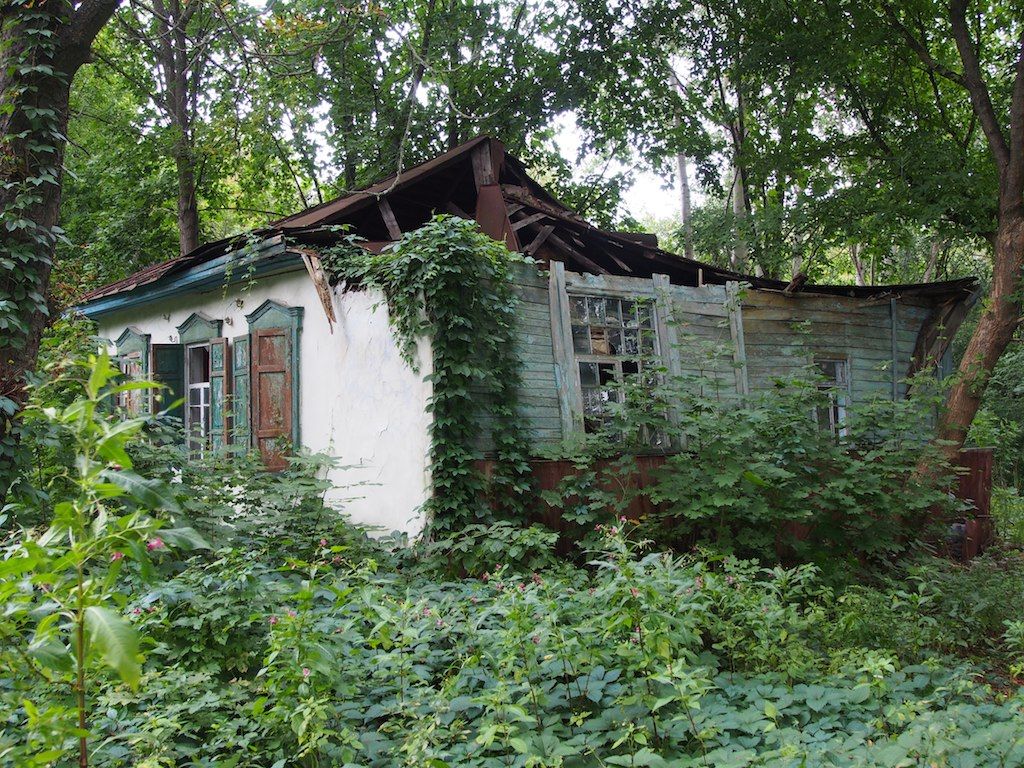Chernobyl: A nuclear accident that changed the course of history. Then came Fukushima.
By Mariana Budjeryn | March 11, 2021
 Abandoned Chernobyl village. Credit: Clay Gilliland via Wikimedia Commons. CC BY-SA 2.0
Abandoned Chernobyl village. Credit: Clay Gilliland via Wikimedia Commons. CC BY-SA 2.0
Editor’s note: This article is part of a collection of expert commentary on nuclear safety published on the tenth anniversary of the Fukushima disaster, produced in a collaboration between the Project on Managing the Atom at Harvard Kennedy School and the Bulletin.
On April 26, 1986, during a planned safety system test at Chernobyl Power Plant’s Unit 4 that involved an electricity shutdown, a series of operator errors led to the meltdown of the graphite-moderated RBMK-type reactor core. Since the reactor was not protected by a containment chamber, the resulting steam explosion tore through the roof of the Unit 4 and rained chunks of fuel rods and radioactive graphite on the surroundings. The fires, spewing clouds of radioactive smoke into the atmosphere, raged for over a week.
Chernobyl still stands for the world’s worst nuclear accident. The full impact of a nuclear disaster on this scale is difficult to compute, not least because the effects that count most are often those that are most difficult to count. Beyond the number of lives lost and people displaced, beyond the money spent on accident mitigation and remediation, there are long-term health, environmental, social, economic, and political consequences that defy quantification. Thirty-five years on, we are still grappling with the full extent of Chernobyl’s impact on the world. Yet in a very real sense, we live in a world shaped by Chernobyl.
As Chernobyl’s radioactive plumes blew over the Soviet border across much of Europe, they brought with them one simple and daunting truth: A nuclear accident anywhere is a nuclear accident everywhere. Chernobyl was a global-scale nuclear event before the world was global, as International Atomic Energy Agency Director-General Rafael Grossi noted during the Nuclear Safety and Security conference at Harvard Kennedy School’s Belfer Center. It jolted the nuclear community into action and much of today’s international regulatory framework on nuclear security emerged in its wake, including the Convention on Nuclear Safety, Convention on Early Notification of a Nuclear Accident, and Convention on Assistance in the Case of a Nuclear Accident or Radiological Emergency.
Today, the nuclear community attributes the Chernobyl accident to a faulty reactor design and an abysmal safety culture. At the time, however, for many Soviet citizens from the leadership to the masses, Chernobyl became symptomatic of the entire Soviet system’s dysfunction, where initiative was punishable, responsibility evaded, and truth inconvenient. And if the Soviet system brought about Chernobyl, Chernobyl brought down the Soviet system.
Then-Soviet leader Mikhail Gorbachev, who hoped to reform the Soviet Union, considered Chernobyl one of the major causes that led to its demise. The accident undermined Gorbachev’s faith in much-touted Soviet technological prowess and its ability to compete with the West, strengthening his commitment to pursue ambitious arms control with the United States. This, in turn, pitched him against the powerful military-industrial sector, whose leaders would conspire against him in August 1991. The August coup and its failure would send the Soviet Union spiraling toward disintegration.
For the Soviet public, the eventual disclosures of the causes of the accident and the grave mishandling of its aftermath compounded the growing dissatisfaction with the authorities in Moscow. That the citizens of Western Europe learned about the accident before the affected populations in Soviet Ukraine, Belarus, and Russia exposed the blatant disregard of the communist apparatchiks for human dignity and wellbeing and stoked public rage. In many corners of the Soviet empire, from Ukraine, to Belarus, to Lithuania, this anti-Moscow sentiment was mobilized by nascent pro-independence movements. If Lithuania and other Baltic republic led the way, it was Ukraine’s steadfast push for independence that obliterated any prospect of keeping the Union intact. When Ukraine did become independent, the Chernobyl trauma contributed to its intention to become a nuclear-free state and relinquish the world’s third-largest nuclear arsenal, inherited from the Soviet Union.
Twenty-five years after Chernobyl, on March 11, 2011, the Fukushima Daiichi nuclear power plant in Japan was struck by an earthquake and a tsunami, resulting in a loss of electricity that disabled cooling systems, compromised reactor containments, melted the reactor cores, and heightened the vulnerability of a spent fuel pool. Subsequent investigation revealed serious problems with the plant’s emergency preparedness, stemming from complacency and collusion between the national nuclear safety regulator and the operator of the plant. Safety culture was once again at the heart of the accident, this time in not in a “backward” Soviet Union but in an industrialized, technologically-savvy, wealthy nation with what had been regarded until that point as strong institutional infrastructures.
Today, the Chernobyl power plant features a new dome over Unit 4, constructed with international assistance. The Ukrainian government has also built a spent nuclear fuel dry-cask storage facility on its grounds. The 30 kilometer radius Chernobyl Exclusion Zone, with its ghost town of Prypiat, the Soviet Duga radar station, and flourishing wildlife has become an unlikely tourist mecca. At Fukushima, after the Japanese government poured billions into clean up and recovery, life is slowly returning. J Village, a national football center, just 20 kilometers from the Fukushima Daiichi plant, reopened in 2018. But only about fifteen percent of some 160 thousand evacuated have returned. Like at Chernobyl, wildlife is taking over spaces vacated by humans.
Amid the renascent verdure, Chernobyl and Fukushima Daiichi power plants stand dormant, sullen testaments to nature’s relentless forces and to human folly and resilience. The world, meanwhile, continues to look to carbon-free nuclear power as a way to meet its energy needs while mitigating climate change. With 440 nuclear reactors in operation globally, over 50 under construction, and close to 200 planned, the nuclear community agrees that the question is not whether another nuclear accident will happen, but rather when it does, how prepared are we to minimize the damage and respond quickly and effectively. The main lesson of Chernobyl and Fukushima is that they will continue to offer lessons to those willing to learn.
Together, we make the world safer.
The Bulletin elevates expert voices above the noise. But as an independent nonprofit organization, our operations depend on the support of readers like you. Help us continue to deliver quality journalism that holds leaders accountable. Your support of our work at any level is important. In return, we promise our coverage will be understandable, influential, vigilant, solution-oriented, and fair-minded. Together we can make a difference.
















While Chernobyl was the worst nuclear disaster, it wasn’t the most massive expulsion of radiation ever. That dishonor goes to an incident in Colorado in 1978. James Loewen’s book Lies Across America explains it in further detail.